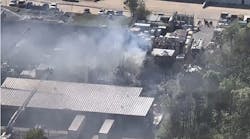The year 2010 has passed, leaving the fire service with a number of interesting and important cases ranging from ground-breaking U.S. Supreme Court decisions to social media nightmares that cost firefighters' their jobs. The following is a fire lawyer's assessment of the most interesting and important fire service legal stories of 2010. The interesting cases are those that capture our attention, while the important cases are those that break new legal ground or impact hundreds if not thousands of firefighters.
The Five Most Interesting Cases of 2010:
Fifth: Feb. 23, 2010 — New York: Bronx Supreme Court Justice Margaret Clancy set aside the 2009 manslaughter conviction of Cesar Rios, the landlord of the apartment building where FDNY Lieutenant Curtis Meyran and Firefighter John Bellew were killed on Jan. 23, 2005, in the Black Sunday fire. Six firefighters were forced to jump from top-floor windows of the building, which had been illegally subdivided. As the basis for her ruling, the judge cited the lack of sufficient evidence to establish that Rios had actual knowledge that tenants made illegal subdivisions.
Fourth: Feb. 10, 2010 — South Carolina: Firefighter/Paramedic Jason Brown of Colleton County Fire Rescue posted an animated video on Facebook depicting an exchange between a firefighter and an emergency room doctor that some considered to be derogatory. He was terminated on Feb. 11 for "displaying poor judgment."
Third: July 17, 2010 — Georgia: Spalding County Firefighter/Paramedic Terrence Reid took a cell phone video of a deceased young woman at the scene of a fatal accident. He forwarded the video to others, who in turn forwarded it to others, and eventually the video was seen by the victim's parents. Reid was terminated in October and six other members of the department were disciplined for their roles in the incident. In speaking about the investigation, Spalding County Assistant County Manager Virginia Martin stated, "The report contains information, not just about the incident of July 17, but also about the culture and things in the fire department that may have created a situation where taking this video and releasing it seemed acceptable to the people involved."
Second: Jan. 12, 2010 — Pennsylvania: Penn Township EMT Jason Fait was found not guilty of vehicular homicide in Westmoreland County Superior Court in the Oct. 30, 2006, accident that killed a prison guard. Fait was driving an ambulance back from a hospital in the pre-dawn hours and ran a red light. The accident was captured on the ambulance's dash cam and the video was instrumental in proving to the jury that Fait simply missed seeing the red light, but was not driving recklessly. In other words — the dash cam proved it was an accident, not a crime.
First: Jan. 24, 2010 — Georgia: Dekalb County firefighters responded to a reported house fire, but apparently failed to fully investigate the situation before returning in service. Crews were called back to the scene a few hours later. By this time, the house was well involved and a female occupant, 74-year-old Ann Bartlett, had perished. Following an investigation, five firefighters were terminated, although three were later reinstated by hearing officers in favor of lesser penalties. The fire chief resigned under pressure from county managers and the family of the victim filed a civil lawsuit against the county and several of the firefighters.
The Five Most Important Cases of 2010:
Fifth: Jan. 5, 2010 — Connecticut: The Connecticut Supreme Court decided the case of Gerardi v. Bridgeport. The Bridgeport Fire Department installed global positioning system (GPS) tracking devices on some new fire prevention vehicles, and several Bridgeport fire inspectors were caught falsifying inspection records for buildings they never visited. The inspectors were terminated and filed suit to challenge the discipline based on a Connecticut law that requires employers to notify employees in writing before they are electronically monitored. The Connecticut Supreme Court ruled that while the fire department violated the law by not notifying the employees about the GPS tracking devices, the law does not give employees a cause of action to sue their employer nor require the exclusion of the electronic monitoring evidence at the disciplinary proceeding.
Fourth: Nov. 9, 2010 — New York: The mass tort litigation arising out of the World Trade Center attack on 9/11 was finally settled for an estimated $625 million to $712.5 million. The unprecedented suit was filed in 2003 on behalf of thousands of firefighters, police officers, and construction and emergency workers who were exposed to toxic substances at the site. There were 10,043 eligible plaintiffs and payouts were expected to begin last month.
Third: Jan. 13, 2010 — New York: Federal District Court Judge Nicholas G. Garaufis ruled that the City of New York was guilty of "intentional discrimination" for not correcting a statistical imbalance between whites and minorities in the FDNY. The ruling essentially held that the failure to address disparate impact (unintentional statistical imbalance) discrimination over a long period constitutes proof of disparate treatment (intentional) discrimination. On Jan. 21, 2010, the judge ruled that the FDNY must hire two African American applicants and one Hispanic applicant for every five firefighters hired, change its hiring process, grant compensation to 7,400 minority applicants of the 1999 and 2002 exams, and give retroactive seniority to 293 individuals. The Jan. 13 and 21 rulings followed Garaufis' July 22, 2009, decision concluding that the city was liable for disparate impact discrimination.
Second: March 10, 2010 — Massachusetts: The U.S. First Circuit Court of Appeals handed down a decision in Foley v. Town of Randolph governing the First Amendment rights of high-ranking government officials such as fire chiefs. Following a house fire that claimed the lives of two young boys on May 17, 2007, Randolph Fire Chief Charles Foley made a public statement to the media that was critical of the town's poor staffing and inadequate funding of the fire department. The town suspended him for three weeks, and Foley responded with a federal lawsuit claiming his statements were protected by the First Amendment. The First Circuit upheld the trial court's dismissal of the case, concluding that Foley was not acting as a citizen when he made the comments, but rather as a public official pursuant to his official duties. Statements made by high-ranking public officials in their official capacities do not have First Amendment protection. The parties later settled the case.
First: May 24, 2010 — Illinois: The U.S. Supreme Court ruled that a discrimination case brought by African American applicants to the Chicago Fire Department in 1995 may go forward. The case focused on the 300-day time frame in which an aggrieved person must file a complaint with the Equal Employment Opportunity Commission (EEOC) following an alleged act of discrimination. The plaintiffs alleged the selection process was biased against minorities. The city denied any wrongdoing, but also argued that any act of discrimination that did occur took place when the test scores were announced. In the city's view, the plaintiffs filed their complaint outside of the 300-day period. The U.S. Supreme Court concluded that separate acts of discrimination occur each time individuals are hired off of a list that was based on a discriminatory process. Because plaintiffs filed their complaint within 300 days of a new class of recruits, the court ruled their case should be allowed to proceed. The case has been remanded back to the lower courts to determine whether indeed the process used was discriminatory.
Like the ocean, the legal landscape that confronts the fire service is in constant motion. Congress and state legislatures pass new laws, various agencies pass new regulations, and courts at federal, state and local levels make decisions that impact the fire service. What will 2011 bring us? Stay tuned.
For more, listen to the February Firehouse® Magazine Insider: Firehouse.com/podcasts.
CURT VARONE has more than 38 years of experience in the fire service, retiring in 2008 as a deputy assistant chief (shift commander) with the Providence, RI, Fire Department. He is now the director of the Fire Service Division of Legal and Liability Risk Management Institute and most recently was the director of the Public Fire Protection Division at the National Fire Protection Association (NFPA). Varone is a practicing attorney licensed in Rhode Island and Maine and is the author of two books, Legal Considerations for Fire and Emergency Services and Fire Officer's Legal Handbook.
USFA Reports On Attic Fires In Residences
The U.S. Fire Administration (USFA) has issued a special report examining the characteristics of Attic Fires in Residential Buildings. Developed by the USFA's National Fire Data Center, the report is based on 2006-to-2008 data from the National Fire Incident Reporting System (NFIRS).
According to the report:
•An estimated 10,000 attic fires in residential buildings occur annually in the United States, resulting in an estimated average of 30 deaths, 125 injuries, and $477 million in property damage
•The leading cause of all attic fires is electrical malfunction (43%)
•The most common heat source is electrical arcing (37%)
•Almost all residential building attic fires are non-confined (99%) and a third of all residential building attic fires spread to involve the entire building
•Nine out of 10 residential attic fires occur in one- and two-family residential buildings
•Residential building attic fires are most prevalent in December (12%) and January (11%) and peak between the hours of 4 and 8 P.M.





